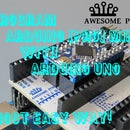Introduction: How to Solder SMD Component on Awesome PCB or Any Other Kind of PCB
Step by step tutorial, with no steps to skip.
Step 1 - What do we need?
Step 2 - Fixing PCB
Step 3 - Preparing for soldering
Step 4 – Rosin
Step 5 - Tin - soldering SMD pad
Step 6 - Soldering 1 pad of SMD component
Step 7 - Soldering 2 pad of SMD component
Step 8 - Placement of the connector
Step 9 - Rosin - Soldering of the connector
Step 10 - Soldering of the connector
Step 11 - Silkscreen on the PCB – value of the component
Step 12 - Check connections with gauge
Step 13 - Assembly PCB in the Bread Board
Step 14 - Additional tips
Step 1: What Do We Need?
To make a long story short first of all Awesome PCB
allowed you to solder any SMD component in package 0603, 0805, 1206, SOT23, SOT223 and use them on the Bread Board when you are making your prototype.
More detail about Awesome PCB you can find here.
What do we need?
1. Awesome PCB or other PCB.
2. SMD component - in our case it will be resistor in package 1206 and value 10k Ohm.
3. Tin - to solder SMD component on the PCB.
4. Resin - to keep clean solder place from contamination.
5. Tweezers - to have a better handle SMD component.
6. Soldering station - to melt tin and solder SMD on the PCB.
7. Insulating adhesive tape - to fix PCB in the one place during soldering of SMD.
8. Gauge - to check result after soldering.
Step 2: Fixing PCB
Mount PCB on flat surface, stick PCB with tape on the flat surface.
Step 3: Preparing for Soldering
Turn on the soldering iron and after the warm-up, soak the tip for 2-3 seconds in the rosin to clean it of impurities.
Step 4: Rosin
If you are using a soldering iron transformer, leave a drop of rosin on the top of the tip.
This will facilitate soldering tin to SMD pad on the PCB in the next step.
Step 5: Tin - Soldering SMD Pad
Cover only one pad of SMD 1206 on the PCB with a small amount of tin, which will melts under the influence of soldering tip temperature.
Covering one pad will allow us to more easily maintain the correct position SMD component and will allowed correct soldering. Pad will be cover by tin and resin.
Step 6: Soldering 1 Pad of SMD Component
Grab SMD component with tweezers, in our case resistor in the housing 1206, and value 10K.
Place SMD component on the proper pads regarding pictures, and solder pad.
Try to keep component symmetrical versus pads on the PCB.
If everything was done properly, component should settle on the surface of the PCB on the place dedicated for package 1206.
Step 7: Soldering 2 Pad of SMD Component
After about 3-4 seconds after the first pad was soldered, proceed to solder 2 pad SMD component. Delay time is needed for staying component on the solder pad. Tin should cool down to avoid unintentional movement of the soldered component.
Step 8: Placement of the Connector
Raster of the hole on the Awesome PCB allowed you to place standard connector (straight pin or bent) with pith 0.1inch (2.54mm). Hole diameter is equal 1.1mm wit tolerances +0.1mm.
Place connector in the holes like it is presented on the picture.
Step 9: Rosin - Soldering of the Connector
This step is similar to Step 3 and Step 4. So if you are using a soldering iron transformer, leave a drop of rosin on the top of the tip.
Step 10: Soldering of the Connector
Solder pins of the connector to the PCB.
Step 11: Silkscreen on the PCB – Value of the Component
On the other side of the PCB there is the dedicated place where you can add value of the component to make a better tracking of it on the Bread Board during prototype phase. Silkscreen can also allow you to store and reuse Awesome PCB in the next future projects.
Step 12: Check Connections With Gauge
After all of the taken steps till now last one will be a checking value of the component with the gauge to make sure that everything is fine.
Connect pin of the gauge to pin 1 and pin 2 of Awesome PCB and make a settings of the Gauge on proper range of the resistance in case of resistor. In presented example rang of gauge is setted for 20k. If SMD component was properly soldered, around 10k will be presented on the display of the gauge.
Step 13: Assembly PCB in the Bread Board
Now Awesome PCB is ready to be place in your Bread Board or prototype circuit.
Step 14: Additional Tips
To make it more easy soldering SMD components, you could use the copper wire with a reduced diameter. Typically, the diameter of the wire solder is in the range of 2-2.5mm. The diameter of the solder wire, which I used is about 0.5mm. Wire about this range of diameter can be taken from ethernet cable.
Please keep in mind that smaller diameter of the wire will heat up faster and it will faster belong degradation compared to wire with higher diameter.
You can also mount on the Awesome PCB other type of SMD components instead of listed 0603, 0805, 1206, SOT23, SOT223.
You can download PDF from all steps from Awesome PCB.






